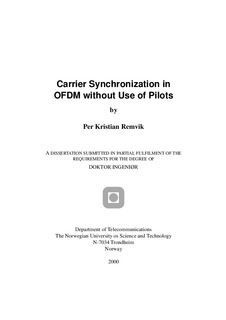| dc.description.abstract | Among new emerging digital communication systems, there is a clear trend of an increasing number of services using high capacity broad band connections, e.g. transfer of images, video and high quality sound. This makes it necessary to find bandwidth efficient modulation formats and efficient channel equalization solutions at the receiver. A modulation format, with possibilities for both relatively simple equalizer structures and bandwidth efficient solutions is Orthogonal Frequency Division Multiplexing (OFDM). The symbol stream is divided into parallel symbol streams, which are modulated on to separate subchannels. The frequency spectra of the subchannels overlap, but the orthogonality of the subchannels are maintained in the time domain at the sampling instant.
To obtain orthogonality between subchannels in OFDM system, one of the assumptions which are made, is exact knowledge of the carrier frequency at the receiver. In the case of a carrier frequency offset (CFO) between transmitter and receiver, the orthogonality between subchannels are lost. With a CFO some of the signal power will be transferred into interference power, i.e. noise, reducing the system performance. All digital transmission systems suffers from performance degradation in the case of a CFO and it is thus important to minimize the CFO, i.e. perform carrier frequency synchronization. The CFO generated interference is special for the OFDM systems and makes them more vulnerable to CFO than single carrier (SC) systems. In addition, the symbol length is increased in OFDM systems compared to SC systems, reducing the amount of CFO tolerated before phase slipping occurs (i.e. erroneous decisions due to CFO generated phase errors). Extra care should be taken in the case of OFDM systems to synchronize the carrier frequency at the receiver with the carrier of the transmitter.
The main topics of this work have been:
• Carrier synchronization in bandwidth efficient OFDM systems on stationary channels. To obtain maximum bandwidth efficiency, neither pilots, guard intervals, repeated sequences or other redundant signalling is used in the proposed methods. Four new OFDM carrier frequency acquisition algorithms are proposed, with performance investigated by simulations. The frequency estimator of Kay is investigated for use in Decision Directed (DD) carrier frequency tracking, with OFDM and non-constant amplitude modulation.
• Consequences of non perfect carrier frequency tracking and time varying transmission channels in OFDM systems. Both OFDM systems using QAM with rectangular pulses and OFDM systems using O-QAM with finite length pulses have been investigated.
Degradation due to non-perfect tracking on stationary channels has been calculated and performance requirements for the developed tracking algorithms are found.
For flat Rayleigh fading channels, degradation due to non-perfect tracking and doppler spread are calculated. | nb_NO |
